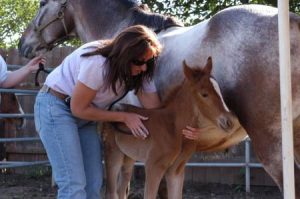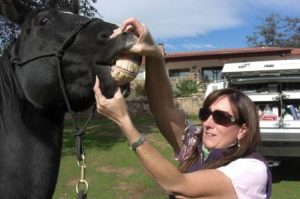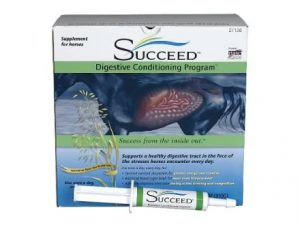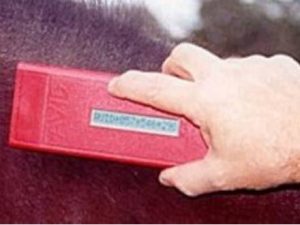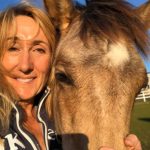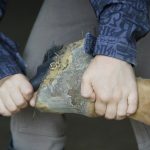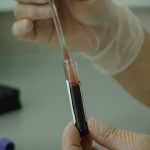+1 619-659-1180
EQUINE ANATOMY
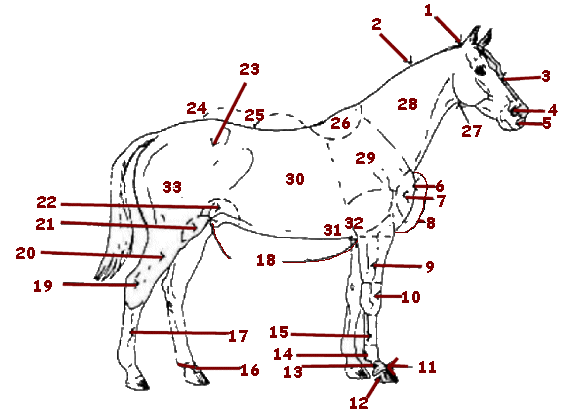
- 1. Poll: The poll is the bony prominence lying between the ears. Except for the ears, it is the highest point on the horses body when it is standing with its head up.
- 2. Crest: Moderately lean in mares but inclined to be more full in stallions. Curved topline of the neck.
- 3. Forehead: The forehead should be broad, full and flat.
- 4. Nostrils: The nostrils should be capable of wide dilation to permit the maximum inhalation of air, yet be rather fine.
- 5. Muzzle: The head should taper to a small muzzle, the lips should be firm and the lower lip should not have the tendency to sag.
- 6. Point of Shoulder: The point of shoulder is a hard, bony prominence surrounded by heavy muscle masses.
- 7. Breast: The Breast is a muscle mass between the forelegs, covering the front of the chest.
- 8. Chest: An ideal chest is deep and contains the space necessary for vital organs. A narrow chest can lead to interference with the front legs. Chest muscles should be well developed and form an inverted "V". The prominence of chest muscling depends on the breed.
- 9. Forearm: The forearm should be well muscled, it extends from the elbow to the knee.
- 10. Knee: The knee is the joint between the forearm and the cannon bone.
- 11. Coronet: The coronet is the band around the top of the hoof from which the hoof wall grows.
- 12. Hoof: The hoof refers to the horny wall and the sole of the foot. The foot includes the horny structure and the pedal bones and navacular bones, as well as other connective tissue.
- 13. Pastern: The pastern extends from the fetlock to the top of the hoof.
- 14 Sesamoid:
- 15. Flexor Tendons: The flexor tendons run from the knee to the fetlock and can be seen prominently lying behind the cannon bone, when it runs parallel to the cannon bone it constitutes the desired "flat bone".
- 16. Fetlock: The fetlock is the joint between the cannon bone and the pastern. The fetlock joint should be large and clean.
- 17. Cannon: The cannon bone lies between the knee and fetlock joint, and is visible from the front of the leg. It should be straight.
- 18. Underline:
- 19. Hock: The hock is the joint between the gaskin and the cannon bone, in the rear leg. The bony protuberance at the back of the hock is called the point of hock.
- 20. Gaskin: The gaskin is the region between the stifle and the hock.
- 21. Stifle: The stifle is the joint at the end of the thigh corresponding to the human knee.
- 22. Flank: The flank is the area below the loin, between the last rib and the massive muscles of the thigh.
- 23. Loin: The loin or coupling is the short area joining the back to the powerful muscular croup ( rump).
- 24. Croup: The croup (rump) lies between the loin and the tail. When one is looking from the side or back, it is the highest point of the hindquarters.
- 25. Back: The back extends from the base of the withers to where the last rib is attached.
- 26. Withers: The withers is the prominent ridge where the neck and the back join. At the withers, powerful muscles of the neck and shoulders attach to the elongated spines of the second to sixth thoracic vertebrae. The height of a horse is measured vertically from the withers to the ground, because the withers is the horse’s highest constant point.
- 27. Throat Latch: The neck should be fine at the throat latch to allow the horse ease of flexation.
- 28. Neck: Lightweight horses should have reasonably long necks for good appearance and proper balance. It should blend smoothly into the withers and the shoulders and not appear to emerge between the front legs.
- 29. Shoulder: Shoulders should be overlain with lean, flat muscle and blend well into the withers.
- 30. Barrel: The barrel should be narrower at the shoulders and widen at the point of coupling (loins).
- 31. Girth: This is the point that a horses should be measured to determine the heart girth which can be used to determine the horses weight.
- 32. Elbow: The elbow is a bony prominence lying against the chest at the beginning of the forearm.
- 33. Hindquarters: The hindquarters give power to the horse. They should be well muscled when viewed from the side and rear.
Conformation, Keeping it all in Balance.
Although a horses basic bady conformation will vary by breed, all horses should have basic "athletic"
structural attributes. A horses conformation determines how will it can perform the functions asked of it .
structural attributes. A horses conformation determines how will it can perform the functions asked of it .
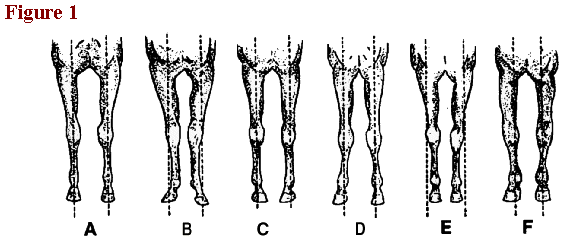
Figure 1
A. Straight legs, good front
B. Splay-footed
C. Pigeon-toed
D. Knock-kneed, norwood front, base wide.
E. Base-narrow
F. Bow-kneed
B. Splay-footed
C. Pigeon-toed
D. Knock-kneed, norwood front, base wide.
E. Base-narrow
F. Bow-kneed
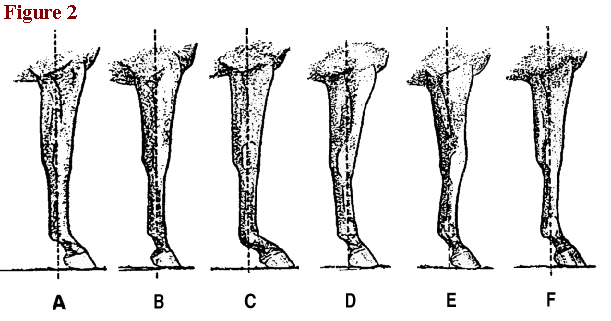
Figure 2
A. Correct, good bone
B. Pastern too straight
C. Pastern too long and flat, angle different than foot, "coon-footed"
D. Calf-kneed, short, straight pastern
E. Buck-kneed or over on the knee
F. "Tied in" or fine babe below the knee.
B. Pastern too straight
C. Pastern too long and flat, angle different than foot, "coon-footed"
D. Calf-kneed, short, straight pastern
E. Buck-kneed or over on the knee
F. "Tied in" or fine babe below the knee.
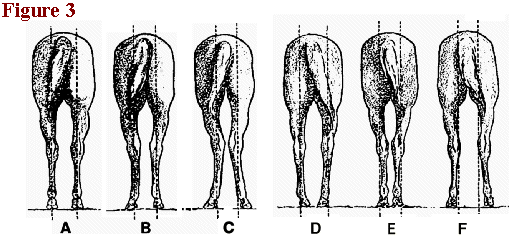
Figure 3
A. Straight legs.
B. Slightly cow-hocked.
C. Extremely cow-hooked, splay-footed
D. Bow-legged or bandy-legged or "too wide," pigeon toed
E. Base-narrow or stands close
F. Base-wide or stands wide
B. Slightly cow-hocked.
C. Extremely cow-hooked, splay-footed
D. Bow-legged or bandy-legged or "too wide," pigeon toed
E. Base-narrow or stands close
F. Base-wide or stands wide
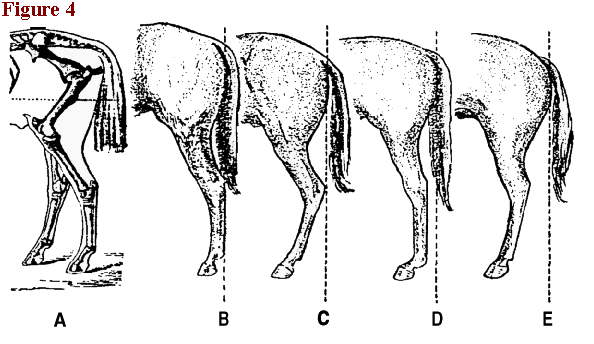
Figure 4
A. Correct skeletal structure.
B. Correct leg set.
C. Sickle-hocked or too much set.
D. Post-legged or to straight - "coon-footed".
E. Comped-under or stands under.
B. Correct leg set.
C. Sickle-hocked or too much set.
D. Post-legged or to straight - "coon-footed".
E. Comped-under or stands under.


